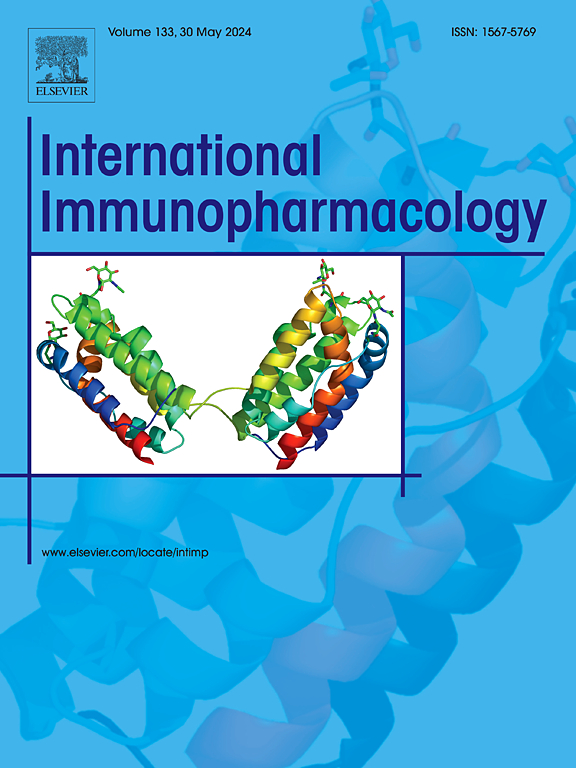Programmed cell death 1 inhibitor combined with chemotherapy compared to chemotherapy alone as first-line treatment in advanced gastric cancer patients: A real-world study
IF 4.8
2区 医学
Q2 IMMUNOLOGY
引用次数: 0
Abstract
Objective
Previous trials have revealed better treatment efficacy of programmed cell death 1 (PD-1) inhibitors combined with chemotherapy as first-line treatments than chemotherapy alone in advanced gastric cancer (GC) patients, but real-world evidence is still lacking. Hence, this real-world study aimed to investigate the efficacy and safety of PD-1 inhibitors plus chemotherapy as first-line treatments compared with chemotherapy alone in advanced GC patients.
Methods
In total, 102 advanced GC patients were allocated into a combination group (receiving chemotherapy combined with a PD-1 inhibitor as a first-line treatment) (n = 48) or a chemotherapy group (receiving chemotherapy only as a first-line treatment) (n = 54) according to their actual treatment regimens.
Results
The objective response rate (ORR) was greater in the combination group than in the chemotherapy group (25.0 % versus 9.3 %, P = 0.033), whereas the disease control rate (DCR) was not different between the groups (83.3 % versus 66.7 %, P = 0.054). Progression-free survival (PFS) was prolonged in the combination group than in the chemotherapy group (P = 0.018). The median (95 % confidence interval) PFS was 19.7 (12.2–27.2) months in the combination group and 16.5 (7.3–25.7) months in the chemotherapy group. Multivariate logistic regression analyses revealed that PD-1 inhibitors combined with chemotherapy were independently associated with an increased ORR (odds ratio: 4.180, P = 0.024), increased DCR (odds ratio: 2.928, P = 0.049), and prolonged PFS (hazard ratio: 0.388, P = 0.030). No difference was found in total or each specific grade III-IV adverse reaction between the groups (all P > 0.05).
Conclusion
Treatment with a PD-1 inhibitor plus chemotherapy as a first-line treatment shows better treatment efficacy with similar safety to that of chemotherapy alone in advanced GC patients.
目的先前的试验显示,在晚期胃癌(GC)患者中,程序性细胞死亡1(PD-1)抑制剂联合化疗作为一线治疗的疗效优于单独化疗,但仍缺乏真实世界的证据。方法将102名晚期胃癌患者根据实际治疗方案分配到联合治疗组(接受化疗联合PD-1抑制剂作为一线治疗)(48人)或化疗组(仅接受化疗作为一线治疗)(54人)。结果 联合用药组的客观反应率(ORR)高于化疗组(25.0% 对 9.3%,P = 0.033),而疾病控制率(DCR)在两组之间没有差异(83.3% 对 66.7%,P = 0.054)。联合治疗组的无进展生存期(PFS)比化疗组更长(P = 0.018)。联合治疗组的无进展生存期中位数(95% 置信区间)为 19.7(12.2-27.2)个月,化疗组为 16.5(7.3-25.7)个月。多变量逻辑回归分析显示,PD-1抑制剂联合化疗与ORR增加(几率比:4.180,P = 0.024)、DCR增加(几率比:2.928,P = 0.049)和PFS延长(危险比:0.388,P = 0.030)独立相关。结论在晚期GC患者中,PD-1抑制剂联合化疗作为一线治疗的疗效更好,安全性与单纯化疗相似。
本文章由计算机程序翻译,如有差异,请以英文原文为准。
求助全文
约1分钟内获得全文
求助全文
来源期刊
CiteScore
8.40
自引率
3.60%
发文量
935
审稿时长
53 days
期刊介绍:
International Immunopharmacology is the primary vehicle for the publication of original research papers pertinent to the overlapping areas of immunology, pharmacology, cytokine biology, immunotherapy, immunopathology and immunotoxicology. Review articles that encompass these subjects are also welcome.
The subject material appropriate for submission includes:
• Clinical studies employing immunotherapy of any type including the use of: bacterial and chemical agents; thymic hormones, interferon, lymphokines, etc., in transplantation and diseases such as cancer, immunodeficiency, chronic infection and allergic, inflammatory or autoimmune disorders.
• Studies on the mechanisms of action of these agents for specific parameters of immune competence as well as the overall clinical state.
• Pre-clinical animal studies and in vitro studies on mechanisms of action with immunopotentiators, immunomodulators, immunoadjuvants and other pharmacological agents active on cells participating in immune or allergic responses.
• Pharmacological compounds, microbial products and toxicological agents that affect the lymphoid system, and their mechanisms of action.
• Agents that activate genes or modify transcription and translation within the immune response.
• Substances activated, generated, or released through immunologic or related pathways that are pharmacologically active.
• Production, function and regulation of cytokines and their receptors.
• Classical pharmacological studies on the effects of chemokines and bioactive factors released during immunological reactions.

 求助内容:
求助内容: 应助结果提醒方式:
应助结果提醒方式:


